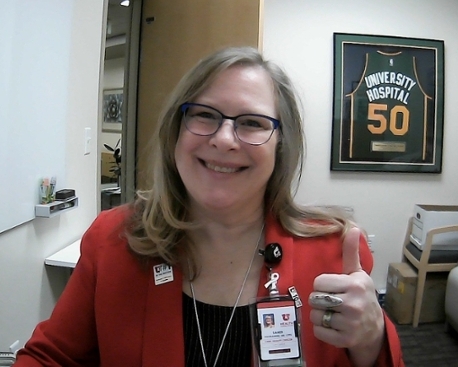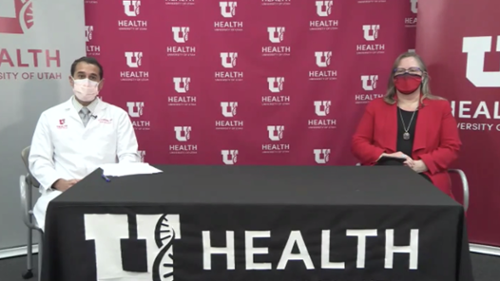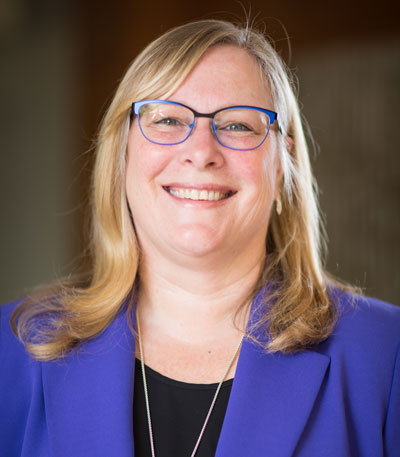Voices of U of U Health
From Industrial Engineer to Chief Quality Officer
My leadership journey at University of Utah Health did not begin in a boardroom. It began in a hospital bed as a patient at University of Utah Hospital in 2006. I had a cervical spine fusion, and although not everything went exactly as planned, I was so impressed with the way these unanticipated events were handled, how my family was included, and how concerned the care teams were for my well-being. I knew I wanted to be a part of this incredible health system.
A year later, I joined U of U Health’s quality team. Little did I know that would ultimately pave the way for me to become chief quality officer (CQO) 13 years later. Now, drawing on my background as an engineer and my own patient experience, I have the privilege of helping to improve outcomes for every patient we serve.
Finding My Passion

When opportunity knocked at U of U Health, I was the senior regional leader for a large American department store chain. Leaving that position to become a frontline quality improvement specialist for an academic medical center was a major shift. But I would do it over in a heartbeat. I have never regretted that decision. This was where I could make the biggest difference.
I have enjoyed many wonderful opportunities here. After being hired as the first non-clinician quality improvement specialist, I co-founded and led the value engineering program. Then I became the director of quality and senior director of system quality, patient safety, and value.
Finally, in November 2020, I assumed my current role as CQO. With our team of teams approach, U of U Health emerged as—and has remained—one of the top academic medical centers in the country for quality and safety.
Power of the Team
I believe in the power of teams. When a multi-disciplinary group of colleagues come together and challenge each other’s ideas, they talk through the possibilities and find better solutions. Everyone’s input is valued. Everyone feels heard, and everyone makes a meaningful contribution to the result. Throughout the COVID-19 pandemic, U of U Health has proven its ability to work together to do what is best for our patients, our team members, and the community.
As a leader, I will never ask others to do things that I am not willing to do. I will work hard and get my hands dirty. I respect and trust my teams and colleagues. I strive to be intentional about who we hire. More often than not, I’m lucky enough to hire people smarter than I am who contribute to diverse thinking. The group of quality consultants I joined initially is now comprised of 50 percent non-clinician and 50 percent clinician employees. This diversity is helping us take exciting steps forward as an organization.
Over the years, I have watched our system evolve into a culture that celebrates successes but never becomes idle. In 2010, when we achieved our first No. 1 national ranking for quality from Vizient, we could have said, “We did it. Our work is done.” Instead, we embraced that moment as an opportunity to do even better.
For us, it has never been about chasing rankings or merit badges. It’s been about finding ways to better care for patients. Our superpower is our people: providers, researchers, trainees, and staff. They keep us focused on continual improvement and learning.
Next Evolution of Quality: Accountability for Outcomes
Building on our proven track record in quality and safety, we are expanding our focus to include being accountable for the outcomes of our patients. Prioritizing the needs of our community and equitable care are critical to our success moving forward.
To truly be accountable for outcomes, we need to better understand where care disparities exist and how our processes may contribute to those disparities. The first step we are taking is to establish a standardized process to collect and analyze data for race, ethnicity, sexual orientation, gender identity, and social determinants of health. As part of those processes, we need to be clear about the rationale for collecting this data. That ensures our patients feel safe when we ask for this information and leads to better care for them.

MD, hosted by U of U Health in Feb. 2021, to encourage the community to continue
seeking preventive health care during the coronavirus pandemic.
At the same time, we realize that when it comes to patient outcomes, we as a health system cannot do it all. We need to align and collaborate with social and community organizations to connect our patients to the resources they need outside of the services we offer.
We will continue evolving our work in patient-reported outcomes (PROs) and clinical-reported outcomes. For example, Rachel Weir, MD, a psychiatrist at U of U Health, has gathered data on the relationship between depression and a patient’s physical health. Weir says PROs are a vital sign in mental health. Different patients have different ideas about quality outcomes. The next evolution of quality challenges us to develop ways of measuring these variables.
Existing quality rankings grade us on things patients expect from us. They wouldn’t choose us if we had a poor mortality rate, for instance. As we look to what’s next in quality improvement, we want to know what matters to patients and providers. We need to ensure that the processes within the system support our providers and staff to deliver the best possible care. That is where we can have the biggest impact on improved care.
Caring for Our Caregivers
Every member of our leadership team cares about employee well-being. As providers continue working under the prolonged stress of the current pandemic, we need to ensure they receive the care they need, too. We must balance our commitment to high-quality care with a commitment to caring for our people.
How do we help them deal with high levels of stress and maintain the elite level of care that we have come to expect? How do we continue moving forward in this environment while allowing high performers a chance to breathe? As a system, we will continue taking proactive steps to address these concerns. As our CEO Michael Good, MD, always says, it’s about taking care of ours teams so we can take care of our community.
We really are in this together! We need and value every single member of the U of U Health team. Weathering this current storm together has only affirmed my conviction that there is no other place I’d rather be than U of U Health. We will get through this, and we will continue to deliver the best care possible for our patients.
